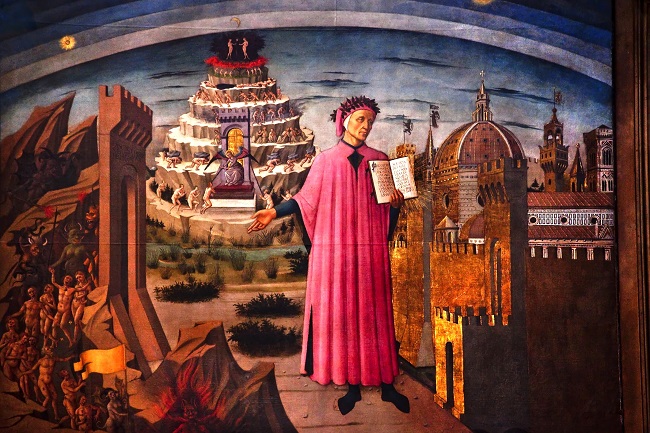Jan 02, 2026
Jan 02, 2026
Epics-8
Florence born Dante Alighieri (1265-1321) wrote the epic poem "The Divine Comedy" in the 14th century. It is believed to be one of the best pieces of writing ever written and a masterpiece of world literature. The poem has three parts: Inferno, Purgatorio, and Paradiso. It takes the reader on a trip through the afterlife, talking about sin, forgiveness, and God.

The first part of "The Divine Comedy" is called "Inferno," and it tells the story of how Dante went to Hell. With the help of the author Virgil, Dante meets different sinners and sees how they are punished based on what they did wrong. Dante paints a clear picture of what happens to people when they do awful things by using detailed and often horrible images. The Inferno is a story meant to teach people about the consequences of their deeds and how important it is to live a good life.
In the second part of the poem, called "Purgatorio," Dante climbs Mount Purgatory. This is a place where people who have repented of their sins but haven't yet reached heaven can be cleansed. Here, Dante meets different penitents who are going through different kinds of purgation, each for a different sin. Purgatorio is about repentance, forgiveness, and the power of divine kindness to change people. It talks about how important self-reflection and personal growth are on the path to spiritual awareness.
The last part of "The Divine Comedy" is called "Paradiso. This is where Dante gets to heaven and sees the beautiful sight. Dante's imagined love interest, Beatrice, leads him to meet saints, angels, and even the Holy Trinity. Paradiso talks about spiritual love, what God is like, and how the human soul can finally be happy. Dante tries to show the indescribable beauty and harmony of the celestial realm by giving detailed accounts and using poetic language.
One of the most interesting things about "The Divine Comedy" is that it is full of allegories. Each part of the poem can be read in different ways, and together they show both the physical journey of the main character and the soul's spiritual journey. Dante's use of symbols and allegories makes it possible to dig deeper into difficult religious and philosophical ideas. It makes people think about their own lives and the nature of sin, forgiveness, and the divine.
The rich cultural and historical background of "The Divine Comedy" is another thing that makes it stand out. Dante gets a lot of his ideas from ancient myths, Bible stories, and medieval Christian theory. In his story, he talks about historical figures, political events, and current problems. This makes the poem a reflection of the intellectual and social climate of his time. This mixing of different things gives the poem depth and complexity, making it a work with many layers that speaks to readers from different times.
"The Divine Comedy" is another example of Dante's skill as an artist. His use of terza rima, which is a type of stanza with three lines, gives the poem a rhythmic and musical feel. Dante is so good with words and pictures that he can clearly describe the landscapes of Hell, Purgatory, and Heaven, as well as the feelings and experiences of the people he meets. His precise and elegant style as a poet is a big part of why the poem has stood the test of time.
In the end, "The Divine Comedy" is a huge drama that explores deep ideas about sin, forgiveness, and God. Dante's "Divine Comedy" has three parts: "Inferno," "Purgatorio," and "Paradiso. These three parts take the reader on a trip through the afterlife that changes them. The poem's use of allegory, its rich cultural background, and the skill with which it is written make it a timeless piece of writing that still moves and inspires readers today. "The Divine Comedy" is a great example of how art can shed light on the human situation and give hints about the mysteries of God.
Here are three Italian verses from The Divine Comedy, along with their English translations and meanings:
1. "Nel mezzo del cammin di nostra vita mi ritrovai per una selva oscura,
ché la diritta via era smarrita."
(Midway upon the journey of our life, I found myself within a forest dark,
For the straightforward pathway had been lost).
These lines are from the opening of the first canto of Inferno (Hell). Dante describes finding himself in a dark forest, symbolizing a state of confusion and being lost in life's journey.
2. "Lasciate ogni speranza, voi ch'entrate."
(Abandon all hope, ye who enter here).
This verse is inscribed on the gates of Hell in Inferno. It serves as a warning to those who enter, indicating that once inside, there is no hope for redemption or escape from the punishments that await.
3. "Amor, ch'a nullo amato amar perdona.
(Love, which permits no loved one not to love).
These lines are from the final tercet of Paradiso (Paradise). Dante expresses the idea that love is a force that compels all beings to love and be loved in return. It signifies the divine nature of love and its power to unite and bring harmony to the universe.
These verses showcase the depth and beauty of Dante's poetic language and provide glimpses into the themes and messages conveyed throughout The Divine Comedy.
Continued to Next Page
Image (c) istock.com
02-Sep-2023
More by : Dr. Satish Bendigiri